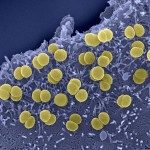Lien vers Pubmed [PMID] – 25290693
Lien DOI – 10.1371/journal.pone.0107612
PLoS One 2014 ; 9(10): e107612
The ability to acquire iron from various sources has been demonstrated to be a major determinant in the pathogenesis of Neisseria meningitidis. Outside the cells, iron is bound to transferrin in serum, or to lactoferrin in mucosal secretions. Meningococci can extract iron from iron-loaded human transferrin by the TbpA/TbpB outer membrane complex. Moreover, N. meningitidis expresses the LbpA/LbpB outer membrane complex, which can extract iron from iron-loaded human lactoferrin. Iron transport through the outer membrane requires energy provided by the ExbB-ExbD-TonB complex. After transportation through the outer membrane, iron is bound by periplasmic protein FbpA and is addressed to the FbpBC inner membrane transporter. Iron-complexing compounds like citrate and pyrophosphate have been shown to support meningococcal growth ex vivo. The use of iron pyrophosphate as an iron source by N. meningitidis was previously described, but has not been investigated. Pyrophosphate was shown to participate in iron transfer from transferrin to ferritin. In this report, we investigated the use of ferric pyrophosphate as an iron source by N. meningitidis both ex vivo and in a mouse model. We showed that pyrophosphate was able to sustain N. meningitidis growth when desferal was used as an iron chelator. Addition of a pyrophosphate analogue to bacterial suspension at millimolar concentrations supported N. meningitidis survival in the mouse model. Finally, we show that pyrophosphate enabled TonB-independent ex vivo use of iron-loaded human or bovine transferrin as an iron source by N. meningitidis. Our data suggest that, in addition to acquiring iron through sophisticated systems, N. meningitidis is able to use simple strategies to acquire iron from a wide range of sources so as to sustain bacterial survival.

